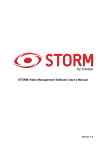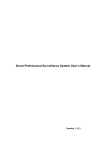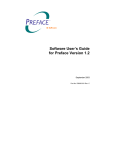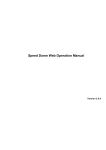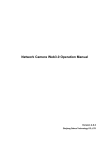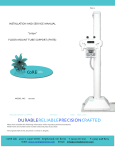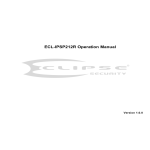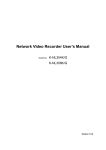Download Optiview VMS User Manual
Transcript
Smart Professional Surveillance System User’s Manual Optiview Inc. 5211 Fairmont Street Jacksonville, FL 32207 Version 1.0.0 (904) 805-1581 • www.optiviewusa.com Table of Contents 1 OVERVIEW AND ENVIRONMENT..................................................................... 1 1.1 Overview ................................................................................................................................................. 1 1.2 Environment ........................................................................................................................................... 1 2 INSTALLATION AND UPGRADE ....................................................................... 2 2.1 Installation............................................................................................................................................... 2 2.2 Un-installation ........................................................................................................................................ 5 3 SETTING ............................................................................................................ 7 3.1 Login Interface ....................................................................................................................................... 7 3.2 Main Interface ........................................................................................................................................ 7 3.3 General.................................................................................................................................................... 8 3.4 Account ................................................................................................................................................. 10 3.4.1 Add user ........................................................................................................................................... 10 3.4.2 Modify or Delete Users................................................................................................................... 12 3.5 Device Manager................................................................................................................................... 12 3.5.1 Add Device....................................................................................................................................... 12 3.5.1.1 Auto add ................................................................................................................................. 12 3.5.1.2 Manual Add ............................................................................................................................ 13 3.5.1.3 Add/Modify Device ................................................................................................................ 14 3.5.2 Group Manager ............................................................................................................................... 14 3.5.3 Parameter Setup............................................................................................................................. 16 3.5.3.1 Network................................................................................................................................... 17 3.5.3.2 Event ....................................................................................................................................... 23 (904) 805-1581 • www.optiviewusa.com i 3.5.3.3 Storage ................................................................................................................................... 28 3.5.3.4 System .................................................................................................................................... 29 3.5.3.5 Info........................................................................................................................................... 36 3.6 Alarm Setup.......................................................................................................................................... 38 3.6.1 Set Alarm Scheme.......................................................................................................................... 38 3.6.2 Alarm Activation Video ................................................................................................................... 41 3.6.3 Enable/Disable/Export Scheme .................................................................................................... 43 3.7 Alarm Input/Output .............................................................................................................................. 43 3.7.1 Alarm Input....................................................................................................................................... 43 3.7.2 Alarm Output.................................................................................................................................... 45 3.8 Signal Sources ..................................................................................................................................... 45 3.8.1 Audio/Video ..................................................................................................................................... 46 3.8.1.1 Audi/Video .............................................................................................................................. 46 3.8.1.2 Snapshot................................................................................................................................. 47 3.8.1.3 Video Overlay ........................................................................................................................ 48 3.8.2 Record .............................................................................................................................................. 49 3.8.2.1 Schedule record/Schedule snapshot.................................................................................. 49 3.8.2.2 Record control........................................................................................................................ 50 3.8.3 Detect ............................................................................................................................................... 51 3.8.4 Picture Property .............................................................................................................................. 54 3.8.5 PTZ ................................................................................................................................................... 55 3.9 TV Wall Configuration ......................................................................................................................... 56 3.10 Tour ....................................................................................................................................................... 58 3.11 PC-NVR ................................................................................................................................................ 60 4 BASIC OPERATION ......................................................................................... 65 4.1 Preview.................................................................................................................................................. 65 4.1.1 Real-time Preview........................................................................................................................... 65 4.1.2 Record .............................................................................................................................................. 67 4.1.3 Snapshot .......................................................................................................................................... 67 4.1.4 PTZ ................................................................................................................................................... 68 4.1.4.1 Preset...................................................................................................................................... 69 4.1.4.2 Tour ......................................................................................................................................... 69 (904) 805-1581 • www.optiviewusa.com ii 4.2 Playback................................................................................................................................................ 71 4.2.1 Playback Record............................................................................................................................. 72 4.2.2 Record List....................................................................................................................................... 73 4.3 Alarm Manager..................................................................................................................................... 75 4.4 Alarm Activation ................................................................................................................................... 76 5 EXTENSION ..................................................................................................... 78 5.1 TV Wall.................................................................................................................................................. 78 5.2 E-map .................................................................................................................................................... 79 5.2.1 Edit E-map ....................................................................................................................................... 79 5.2.2 Preview E-map ................................................................................................................................ 80 5.3 Device Display Control ....................................................................................................................... 80 5.4 Local Data............................................................................................................................................. 81 (904) 805-1581 • www.optiviewusa.com iii Welcome Thank you for using our Smart Professional Surveillance System (Smart PSS)! This user’s manual is designed to be a reference tool for operation of your system. Here you can find detailed operation information about Smart PSS. (904) 805-1581 • www.optiviewusa.com iv 1 Overview and Environment 1.1 Overview Smart PSS is an abbreviation for Smart Professional Surveillance System. It is software to manage small quantity security surveillance devices. It releases with the device and does not support the products from other manufacturers. It has the following features: z View real-time video of several camera channels. z View the playback video files from various cameras. z Support multiple scheduled arms to realize auto PC guard. z Support e-map; you can clearly view and manage all device locations. z TV wall plan setup and can output TV wall video at the same time. z It can create individual configuration files for each user, which allows you maintain your own habit and style. z Support extension applications, can send out alarm information to external programs. 1.2 Environment Item Requirements OS Windows 2000/Windows XP/Windows 2003/Window Vista/Win7. CPU 2.4GHz or higher. Display card Independent car and support directX 8.0c or higher. Memory 1GB or higher. Displayer Resolution 1024×768 or higher. (904) 805-1581 • www.optiviewusa.com 1 2 Installation and Upgrade 2.1 Installation 1) Double click “OptiviewVMS_ver.1.11.1.R.9.10.2014.B.exe” to begin installation. See Figure 2-1. Figure 2-1 2) Select installation language from the dropdown list and then click OK button to go to Welcome interface. See Figure 2-2. Figure 2-2 3) Click next button, you can see an interface is shown as in Figure 2-3. Here you can view End user License Agreement. (904) 805-1581 • www.optiviewusa.com 2 Figure 2-3 4) Please check the Accept item and then click Next button to continue. System pops up module installation dialogue box. See Figure 2-4. Figure 2-4 5) Check Smart PSS item and then click Next button, you can see there is an interface asking you to specify installation path. See Figure 2-5. Note You can check PC-NVR item if necessary. (904) 805-1581 • www.optiviewusa.com 3 Figure 2-5 6) After you select installation path click Next button, system begins installation. The interface is shown as in Figure 2-6. Figure 2-6 7) During the installation process, you can click Cancel button to exit. After installation, you can see an interface is shown as below. See Figure 2-7. (904) 805-1581 • www.optiviewusa.com 4 Figure 2-7 8) Click Finish button, you can complete the installation. 2.2 Un-installation 1) From Start -> All programs->Smart PSS, select Uninstall Smart PSS item. System pops up the following dialogue box. See Figure 2-8. Please click yes to remove PSS. Figure 2-8 2) 3) Click Next button, you can see an interface shown as in Figure 2-9. Check the box here to remove Smart PSS. You can check the box to remove PC-NVR too. Click Uninstall button to remove. (904) 805-1581 • www.optiviewusa.com 5 Figure 2-9 (904) 805-1581 • www.optiviewusa.com 6 3 Setting Double click Smart PSS icon , you can go to the login interface. 3.1 Login Interface Login interface is shown as in Figure 3-1. z User name: Input the user account z Password: Please input corresponding password to log in. z OK: Click this button, system can verify the account and then enter the software main interface. z Cancel: Click this button to exit login interface. Note: z If it is your first time to run the Smart PSS program, default user name is admin and its password is admin too. Admin is a super administrator and can not be removed. It can add, modify or delete other user. z For security reason, please modify your password after first log in. z You can memory your password, so that when you can log in the next time, you do not need to input user name and password. Please note this function is for your convenient only. Do not enable this function in public PC. Figure 3-1 3.2 Main Interface Click Login button, system begins verifying user name and password and then go to the main interface. See Figure 3-2. (904) 805-1581 • www.optiviewusa.com 7 Figure 3-2 Please refer to the following sheet for detailed information. SN Parameter Function 1 Menu Here you can view main page icons and current open function icon. 2 Basic It includes preview, playback, alarm manager, alarm link and etc. 3 Extension It includes TV wall, e-map, device display control and etc. 4 Setting It includes basic configuration, alarm configuration, alarm input/output, signal source, TV wall configuration, device manager, user manager, PC-NVR manager, monitor task setup and etc. 5 Smart PSS basic information It is to display current time, user information, login time. 3.3 General If it is your first time to login the Smart PSS, you need to set system parameter. It includes network performance, log save time, login Smart PSS or not, picture and record saved path. Please follow the steps listed below. Click the button; you can go to the general interface. See Figure 3-3. (904) 805-1581 • www.optiviewusa.com 8 Figure 3-3 Please refer to the following sheet for detailed information. Item Function Network function It is for you to set network function. It includes: “WAN”, “10M”,’100M’,”1000M”. Log period save Here you can set log save time. System automatically overwrites old files once it reaches the period you set here. It includes; 1/2/3/4/5/6month. Auto login Smart PSS Check the box here, you can login Smart PSS directly without inputting user name and password. Auto login Windows Check the box here and then input user name and password, you can go to the Windows OS after the computer restart. Auto time Check the box here to enable time synchronization function and then input synchronization time. Smart PSS can auto synchronize time with the PC at the time you specified. Default sync Click it to restore system default setup. File configuration interface is shown as below. See Figure 3-4. Here you can set snapshot picture and record file default save path. (904) 805-1581 • www.optiviewusa.com 9 Figure 3-4 You can click Default button to restore factory default setup. 3.4 Account Here you can add, modify or delete a user. 3.4.1 Add user 1) Click in the Setting pane, you can go to the following interface. See Figure 3-5. Figure 3-5 (904) 805-1581 • www.optiviewusa.com 10 2) Click Add button, you can see system pops up the following interface. See Figure 3-6. Figure 3-6 3) Select user type, input user name, password and confirm password. Input some description information if necessary. Select rights for the new user. 4) Click add button to add a new user. Or you can click Add more button if you want to add more new users. Please refer to the following sheet for detailed information. Item Function User type You can select user type from the dropdown list. It includes: manager/operator. User name Please input user name here. Password Please set user password. Confirm password Please input new password again. Details You can input some description information here if necessary,. User authority Here you can check the box to select corresponding rights for current user. If the new user is a manager, system checks all rights by default. Add more Check the box here if you want to add more users. (904) 805-1581 • www.optiviewusa.com 11 3.4.2 Modify or Delete Users Select a user in the list, and then click to modify, or click to delete it. Or you can select several users and then click the Delete button at the left bottom corner to remove them all. 3.5 Device Manager Here you can add, modify and delete a device. You can also implement device channel group function. 3.5.1 Add Device You can refer to the steps listed below to add, modify or delete a device manually or automatically. 3.5.1.1 Auto add 1) Click icon, system goes to the device manager interface; you can see an interface is shown as in Figure 3-7. Figure 3-7 2) 3) Click Auto add button, you can see an interface shown as in Figure 3-8. Please check the box to select the devices you want to add and then click the Add button. (904) 805-1581 • www.optiviewusa.com 12 Figure 3-8 3.5.1.2 Manual Add Click Manual Add button, the interface is shown as in Figure 3-9. Please input the corresponding information and then click Add button. Figure 3-9 Please refer to the following sheet for detailed information. (904) 805-1581 • www.optiviewusa.com 13 Item Function Device name Please input a device name here. Group name It defined by the device name. Type Select a device type from the dropdown list.。 IP/Domain name Device IP address or domain name. Port Device IP port. User name The user name you login the device. Password The password you login the device. Getting info It is to get the online device information automatically. Device model Device model. Read-only. Device SN Device SN. Read-only. Video input Device video input channel amount. Video output Device video output channel amount. Alarm input Device alarm input amount. Alarm output Device alarm output amount. Continuous add Click it to add more devices. Create Group Add current device to group manager interface as one new group. 3.5.1.3 Add/Modify Device Select a device in the list, and then click to modify, or click to delete it. Or you can select several devices and then click the Delete button at the left bottom corner to remove them all. 3.5.2 Group Manager Note z For a device or a channel that is not included in the group management mode, you can not view it on the device list of the Preview interface. z You do not need to implement group management if you have checked the box on Figure 3-9 when you add a new device. (904) 805-1581 • www.optiviewusa.com 14 After you add devices, you can set channel group to manage it. 1) Right click the at the top right pane on Figure 3-7, you can go to the following interface. See Figure 3-10. Figure 3-10 2) Click the New group button at the right top corner, you can create new group. Note z z You can double click group name to change its name. Or you can right click a group name to rename or delete it. to delete it. You can select a group and then click the button 3) On the Device list on the right pane, you can select a device. You can view the corresponding channel name on the near pane. 4) Select corresponding channels and then click 5) group you created here. See Figure 3-11. Double click a channel; you can change its name. Click Finish button to complete the setup. , you can add channels to the new (904) 805-1581 • www.optiviewusa.com 15 Figure 3-11 Tips You can user Ctrl+left click mouse to select several channels at the same time. Or you can user Ctril+A to select all channels. 3.5.3 Parameter Setup After you added a new device, you can select it and then click button at the operation column on the device manager interface. It is for you to set device parameters. See Figure 3-12. Figure 3-12 (904) 805-1581 • www.optiviewusa.com 16 Tips ) and click the You can go to the signal sources interface ( at the left bottom to go to the device setup interface. button 3.5.3.1 Network 3.5.3.1.1 TCP/IP Here you can set corresponding parameter when you are using TCP/IP connection. See Figure 3-13. Figure 3-13 3.5.3.1.2 Connect Here you can set max login account amount, TCP port, UDP port, HTTP port, RTSP port and etc. See Figure 3-14. (904) 805-1581 • www.optiviewusa.com 17 Figure 3-14 3.5.3.1.3 PPPoE PPPoE interface is shown as below. See Figure 3-15. Input “PPPoE name” and “PPPoE password” you get from your ISP (Internet service provider). Click OK button, you need to restart to activate your configuration. After rebooting, device will connect to internet automatically. The IP in the PPPoE is the device dynamic value. You can access this IP to visit the device. Figure 3-15 (904) 805-1581 • www.optiviewusa.com 18 3.5.3.1.4 DDNS DDNS setup interface is shown as in Figure 3-16. You need a PC of fixed IP in the internet and there is the DDNS software running in this PC. In other words, this PC is a DNS (domain name server). In network DDNS, please select DDNS type and highlight enable item. Them please input your PPPoE name you get from you IPS and server IP (PC with DDNS ) . Click OK button and then reboot system. Click Ok button, system prompts for rebooting to get all setup activated. After rebooting, open IE and input as below: http://(DDNS server IP)/(virtual directory name)/webtest.htm Figure 3-16 Please refer to the following sheet for detailed information. Parameter Function Server Type You can select DDNS protocol from the dropdown list and then enable DDNS function. Server IP DDNS server IP address Server Port DDNS server port. Domain Name Your self-defined domain name. User The user name you input to log in the server. Password The password you input to log in the server. Update interval Device sends out alive signal to the server regularly. You can set interval value between the device and DDNS server here. 3.5.3.1.5 IP Filter IP filter interface is shown as in Figure 3-17. You can add IP in the following list. (904) 805-1581 • www.optiviewusa.com 19 After you enabled whitelist function, only the IP listed below can access current device. If you enable blacklist function, the following listed IP addresses can not access current device. Figure 3-17 3.5.3.1.6 SMTP (Email) The SMTP interface is shown as in Figure 3-18. Here you can set email receiver, encryption mode, send out interval and etc. Figure 3-18 (904) 805-1581 • www.optiviewusa.com 20 Please refer to the following sheet for detailed information. Parameter Function Enable Please check the box here to enable email function. SMTP Server Input server address and then enable this function. Port Default value is 25. You can modify it if necessary. Anonymity For the server supports the anonymity function. You can auto login anonymously. You do not need to input the user name. password and the sender information. User Name The user name of the sender email account. Password The password of sender email account. Sender Sender email address. Encryption mode System supports SSL/NONE/TLS. Subject Input email subject here. Attachment System can send out the email of the snapshot picture once you check the box here. Receiver Input receiver email address here. Max three addresses. Interval The send interval ranges from 0 to 3600 seconds. 0 means there is no interval. Please note system will not send out the email immediately when the alarm occurs. When the alarm, motion detection or the abnormity event activates the email, system sends out the email according to the interval you specified here. This function is very useful when there are too many emails activated by the abnormity events, which may result in heavy load for the email server. Please check the box here to enable this function. Health mail enable Health mail interval Test 3.5.3.1.7 This function allows the system to send out the test email to check the connection is OK or not. Please check the box to enable this function and then set the corresponding interval. System can send out the email regularly as you set here. The system will automatically sent out a email once to test the connection is OK or not .Before the email test, please save the email setup information. Multicast The multicast interface is shown as in Figure 3-19. Multicast is a transmission mode of data packet. When there is multiple-host to receive the same data packet, multiple-cast is the best option to reduce the broad width and the CPU load. The source host can just send out one data to transit. This function also depends on the relationship of the group member and group of the outer. (904) 805-1581 • www.optiviewusa.com 21 Figure 3-19 3.5.3.1.8 Alarm Server The alarm centre interface is shown as below. See Figure 3-20. This interface is reserved for you to develop. System can upload alarm signal to the alarm centre when local alarm occurs. Before you use alarm centre, please set server IP, port and etc. When an alarm occurs, system can send out data as the protocol defined, so the client-end can get the data. Figure 3-20 (904) 805-1581 • www.optiviewusa.com 22 3.5.3.2 Event 3.5.3.2.1 Alarm Before operation, please make sure you have properly connected alarm devices such as buzzer. The input mode includes local alarm and network alarm. The local alarm interface is shown as in Figure 3-21. Figure 3-21 Figure 3-22 (904) 805-1581 • www.optiviewusa.com 23 Figure 3-23 Please refer to the following sheet for detailed information. Parameter Function Enable You need to check the box to enable this function. Please select a channel from the dropdown list. Arm/disarm Period This function becomes activated in the specified periods. There are six periods in one day. Please draw a circle to enable corresponding period. Select date. If you do not select, current setup applies to today only. You can select all week column to apply to the whole week. Click OK button, system goes back to local alarm interface, please click OK button to exit. Anti-dither Device (Sensor) type Record Delay Output delay System only memorizes one event during the anti-dither period. There are two options: NO/NC. System can delay the record for specified time after alarm ended. System can delay the alarm output for specified time after an alarm ended. Video matrix System auto activates motion detection channel(s) to record once an alarm occurs. Please make sure you have set MD record in Record interface (Main Menu->Setting>Signal sources). Enable alarm activation function. You need to select alarm output port so that system can activate corresponding alarm device when an alarm occurs. Check the box here to enable video matrix function. Show message System can pop up a message to alarm you in the local Record channel Alarm output (904) 805-1581 • www.optiviewusa.com 24 Parameter Function host screen if you enabled this function. Buzzer Check the box here to enable this function. The buzzer beeps when an alarm occurs. Alarm upload System can upload the alarm signal to the centre (Including alarm centre. Send Email If you enabled this function, System can send out an email to alert you when an alarm occurs. SMS If you enabled this function, System can send out a message to specified phone to alert you when an alarm occurs. Tour You need to check the box here to enable this function. PTZ Activation Here you can set PTZ movement when alarm occurs. Such as go to preset X. 3.5.3.2.2 Abnormality It includes six statuses: No device, no space, device error, net offline, IP conflict and MAC conflict. See Figure 3-24 through Figure 3-29. Figure 3-24 (904) 805-1581 • www.optiviewusa.com 25 Figure 3-25 Figure 3-26 (904) 805-1581 • www.optiviewusa.com 26 Figure 3-27 Figure 3-28 (904) 805-1581 • www.optiviewusa.com 27 Figure 3-29 Please refer to the following sheet for detailed information. Parameter Function Enable Check the box here to enable selected function. Alarm Output Please select corresponding alarm output channel when an alarm occurs. You need to check the box to enable this function. Output delay The alarm output can delay for the specified time after an alarm stops. Show message System can pop up a message to alarm you in the local host screen if you enabled this function. Alarm upload System can upload the alarm signal to the centre (Including alarm centre. Send Email If you enabled this function, System can send out an email to alert you when an alarm occurs. Buzzer Check the box here to enable this function. The buzzer beeps when an alarm occurs. SMS If you enabled this function, System can send out a message to specified phone to alert you when an alarm occurs. 3.5.3.3 Storage 3.5.3.3.1 Local Store The local interface is shown as in Figure 3-30. Here you can save data to local SD card or HDD. (904) 805-1581 • www.optiviewusa.com 28 Figure 3-30 3.5.3.3.2 Remote store It is for you to upload data to a PC via FTP. See Figure 3-31. Figure 3-31 3.5.3.4 System 3.5.3.4.1 Host Here you can set system time, date format, record period and etc. See Figure 3-32. (904) 805-1581 • www.optiviewusa.com 29 Figure 3-32 Please refer to the following sheet for detailed information. Parameter Function Device name It is to set device name. Device No. When you are using one remote control to manage multiple devices, you can give a serial numbers to the device. Before the operation, please make sure you have clicked address button on the remote control and input an number for current device. Language You can select the language from the dropdown list. Please note the device needs to reboot to get the modification activated. Video Standard This is to display video standard such as PAL. HDD full Here is for you to select working mode when hard disk is full. There are two options: stop recording or rewrite. z If current working HDD is overwritten or the current HDD is full while the next HDD is no empty, then system stops recording, z If the current HDD is full and then next HDD is not empty, then system overwrites the previous files. Here is for you to specify record duration. Pack duration 3.5.3.4.2 Date The date and time interface is shown as in Figure 3-33. (904) 805-1581 • www.optiviewusa.com 30 Figure 3-33 Please refer to the following sheet for detailed information. Parameter Function Date format Here you can select date format from the dropdown list. Time Format There are two options: 24-H and 12-H. Time zone The time zone of the device. System time It is to set system time. It becomes valid after you set. Sync PC You can click this button to save the system time as your PC current time. DST enable Here you can set day night save time begin time and end time. You can set according to the date format or according to the week format. NTP You can check the box to enable NTP function. NTP server You can set the time server address. Port It is to set the time server port. Update period It is to set the sync periods between the device and the time server. 3.5.3.4.3 Account Here you can add/modify/delete a group or add/modify/delete a user. System default user group is admin/user. System default user is admin/888888/666666. (904) 805-1581 • www.optiviewusa.com 31 Here we are going to add a new user overseas under group Test. In the following interface, click Add group button. See Figure 3-34. Figure 3-34 You can see system pops up the following interface. See Figure 3-35. Please input a group name such as Overseas and then select corresponding rights, input some note information if necessary. Click OK button to exit. Figure 3-35 Go to the User interface, here you can add/remove user and modify user name. See Figure 3-36. (904) 805-1581 • www.optiviewusa.com 32 Figure 3-36 Click Add user button, you can see the following interface. See Figure 3-37. Please input user name such as Test, password, and select group Overseas from the dropdown list. Select corresponding rights and then click OK button. Tips If you want to multiple users to use this account login at the same time, you need to check the box to select reusable function. Figure 3-37 (904) 805-1581 • www.optiviewusa.com 33 Now you can see you have added a new user “Test” under group Overseas. See Figure 3-38. Figure 3-38 3.5.3.4.4 Remote Setup Here you can add remote device manually or automatically. See Figure 3-39. Figure 3-39 (904) 805-1581 • www.optiviewusa.com 34 Click Search device button, system can list all the devices on the same IP section. Select a device and then click Add button; you can add a remote device. Click Manual add button, System pops up the following dialogue box. See Figure 3-40. Please input the corresponding information and then click OK button to add a remote device. Figure 3-40 3.5.3.4.5 RS232 The RS232 interface is shown as in Figure 3-41. Figure 3-41 (904) 805-1581 • www.optiviewusa.com 35 Please refer to the following sheet for detailed information. Parameter Function COM You can select from the dropdown list. Function Baud Rate There are various devices for you to select. z Console is for you to use the COM or mini-end software to upgrade or debug the program. z The control keyboard is for you to control the device via the special keyboard. z Transparent COM (adapter) is to connect to the PC to transfer data directly. z Protocol COM is for card overlay function. z Network keyboard is for you to use the special keyboard to control the device. Default setup is 115200. Data Bit Default setup is 8. Stop bit Default setup is 1. Parity Default setup is none. 3.5.3.4.6 Auto Maintenance Here you can set auto-reboot time and auto-delete old files setup. You can set to delete the files for the specified days. See Figure 3-42. Figure 3-42 3.5.3.5 Info Here you can view system version information, log information and backup log files to PC. 3.5.3.5.1 Version Version interface is shown as below. See Figure 3-43. (904) 805-1581 • www.optiviewusa.com 36 Figure 3-43 3.5.3.5.2 Log Log interface is shown as in Figure 3-44. Select start time/end time, and select type from the dropdown list. Click Query button, you can see the log information. Select one log file, you can view its detailed information at the bottom of the interface. Figure 3-44 (904) 805-1581 • www.optiviewusa.com 37 3.6 Alarm Setup 3.6.1 Set Alarm Scheme Note Before you set alarm scheme, you need to set alarm input channel and group on the alarm input/output interface. Please refer to chapter 3.7. You can follow the steps listed below to set an alarm scheme. 1) Click the icon , you can go to alarm configuration interface. See Figure 3-45. Figure 3-45 2) Click Add button, you can set scheme information. See Figure 3-46. Please refer to the following sheet for detailed information. Item Function Scheme name Please input a scheme name here. Memo You can input some description information here if necessary. (904) 805-1581 • www.optiviewusa.com 38 Time Input arm/disarm period and select corresponding level. z All-day: It is to arm the alarm scheme for a whole day. z Period: You can set different periods for each scheme. You can use period. to add period, or you can use to delete Note: On period mode, the rest period here refers to the free periods you have not set. Audio It is to set alarm sound. z Alarm type: It is to select alarm type you want to enable sound function. z Sound path: Select audio file path. You can click Browse button to select the audio file you want to use. z Loop play: Check the box here, system can play the audio repeatedly when a corresponding alarm occurs. z Play: Click it to hear current audio file. z Default: For non-customized alarm type, you can click this button to restore default setup. Others Check the “E-map flash when an alarm occurs”, you can see the corresponding icon on the e-map flashes when an alarm occurs. Figure 3-46 3) Set alarm source. a) Click , system goes to alarm source setup interface. Or you can click next button in Figure 3-46 to go to the following interface. See Figure 3-47. (904) 805-1581 • www.optiviewusa.com 39 b) Here you can select channel you want to set alarm scheme on the left pane and then check the alarm type. c) Click , you can add alarm source to the right pane. See Figure 3-47. . Figure 3-47 Note You can select corresponding alarm source on the right pane and then click to delete an alarm source. d) Click Alarm input label on the left pane, check the alarm input channel. See Figure 3-48. Figure 3-48 (904) 805-1581 • www.optiviewusa.com 40 e) Click OK button, you can view the scheme information on the alarm setup interface. See Figure 3-49. Figure 3-49 Note z If you want to set alarm activation video, you can click Next button in Figure 3-47, or you can click z to set. In Figure 3-49, you can select an alarm scheme and then select Delete button to remove. 3.6.2 Alarm Activation Video Note Before you set alarm activation video, you need to go to alarm input/output interface to set alarm output channel and group. See chapter 3.7. This function allows you to set activation video when an alarm occurs. , you can go to alarm configuration interface. 1) Click icon 2) Double click the 3) Or you can click the Next button at the right bottom of the alarm source setup interface to go to alarm activation video interface. Select alarm source on the left pane. 4) Click link video to set preset and stay time, check the activation channel and click , system goes to alarm activation video interface. . Now you can view the alarm activation video on the right pane. See Figure 3-50. (904) 805-1581 • www.optiviewusa.com 41 Figure 3-50 Note z In Figure 3-50, you can double click stay time to change its contents. z You can select a scheme and then click 5) 6) Click alarm output label, you can go to alarm output interface. See Figure 3-51. Here you can check the box to enable auto output device function and input stay time. 7) Please select channels from the device channel list and then click output. Or you can change setup directly on the right pane. Click OK button to complete setup. to remove activation video. (904) 805-1581 • www.optiviewusa.com to add activation 42 Figure 3-51 3.6.3 Enable/Disable/Export Scheme After you added scheme, click the Open on State column, you can see it becomes disable. Click it again to enable current scheme, you can see state is open now. Click / button to import/export scheme. 3.7 Alarm Input/Output 3.7.1 Alarm Input Here is for you to set alarm input device group. Please follow the steps listed below. 1) Click button 2) input/output interface. Click Alarm Input button, you can go to the following interface. See Figure 3-52. at the setting pane on the main interface. You can go to the alarm (904) 805-1581 • www.optiviewusa.com 43 Figure 3-52 3) Click New group button at the top right of the interface, you can add a new group here. Tips z 4) 5) Double click group name, you can rename it. Or you can right click group name to delete or rename it. z Select a group and then click Del group button, you can delete a group. Select alarm device on the left pane and you can view its alarm channel on the device name pane. , you can add selected alarm channel to Select corresponding channel name and click the corresponding group. You can view alarm channel on the group name pane. Figure 3-53 (904) 805-1581 • www.optiviewusa.com 44 Tips z You can user Ctrl+left click channel to select several channels at the same time. Or you can user Ctril+A to select all channels. z Select a channel from the group, click button you can delete it. Now, please click go back to the home page and then click alarm manager on the basic pane, click Query List label and then click the Alarm Input label on the right pane, you can view you newly added alarm input group. Note You can not view alarm input device if there is no alarm input device group. 3.7.2 Alarm Output Here is for you to set alarm output group and control alarm output. For detailed operation steps, please refer to chapter 3.7.1. Click Close/open button on the alarm output channel name, you can enable/disable alarm output. See Figure 3-54. Figure 3-54 3.8 Signal Sources Here is for you to set channel audio/video bit stream, resolution, overlay information, record plan, video detect, picture property, and PTZ. Here you can also set device network function, alarm setup, storage management, system parameter, and version and log information. (904) 805-1581 • www.optiviewusa.com 45 On the main interface, click button on the setting pane. System goes to the following interface. See Figure 3-55. On the left pane, you can double click a channel name to set its corresponding information. Figure 3-55 3.8.1 Audio/Video 3.8.1.1 Audi/Video The interface is shown as below. See Figure 3-56. Here you can set audio/video bit stream. Figure 3-56 (904) 805-1581 • www.optiviewusa.com 46 Please refer to the following sheet for detailed information. Parameter Function Video enable Check the box here to enable extra stream video. This item is enabled by default. Stream type It includes main stream, motion stream and alarm stream. You can select different encode frame rates form different recorded events. Encode mode It is to set audio/video encode mode. Default setup is H.264. Resolution System supports various resolutions, you can select from the dropdown list. FPS PAL:1~25f/s;NTSC:1~30f/s. Bit stream In VBR mode, it is the max value of the bit stream. In the CBR mode, it is a fixed value. Quality You can select from the dropdown list. Audio encode mode Check the box here to enable audio function and select encode type from the dropdown list. Watermark enable /watermark character This function allows you to verify the video is tampered or not. Copy Click it to copy current setup to other channel(s). Here you can select watermark bit stream, watermark mode and watermark character. Default character is DigitalCCTV. 3.8.1.2 Snapshot The snapshot interface is shown as below. See Figure 3-57. Figure 3-57 (904) 805-1581 • www.optiviewusa.com 47 Please refer to the following sheet for detailed information. Parameter Function Snapshot type There are three modes. z Normal: It enables snapshot function as you set on the snapshot plan. z MTD: It enables snapshot function when motion detect occurs. z Alarm: It enables snapshot function when alarm occurs. Image size It is the same with the resolution of the main stream. Quality It is to set the image quality. Interval It is to set snapshot frequency. Copy Click it; you can copy current channel setup to other channel(s). 3.8.1.3 Video Overlay Here is for you to overlay information on the video. See Figure 3-58. Figure 3-58 Please refer to the following sheet for detailed information. Parameter Function Area-overlay There are two types: Local preview/network monitor. (Privacy mask) Local preview: It is to shield the corresponding video under local preview mode. Network monitor: It is to shield the corresponding video under network monitor mode. Click button to set privacy mask zone. (904) 805-1581 • www.optiviewusa.com 48 Channel display You can enable this function so that system overlays channel information in video window. Please input channel name here. You can use the mouse to drag the channel title position. Time display You can enable this function so that system overlays time information in video window. You can use the mouse to drag the time title position. You can view time title on the live video of the WEB or the playback video. Date format Select date format from the dropdown list if you want to overlay date. Time format Select date format from the dropdown list if you want to overlay date. Copy Click it; you can copy current channel setup to other channel(s). 3.8.2 Record 3.8.2.1 Schedule record/Schedule snapshot You can set the corresponding period to enable schedule record/snapshot function. You can follow the steps listed below to set schedule record function. 1) 2) to go to the device setup interface. On the main interface, click Click record button, you can go to the following interface. See Figure 3-59. Figure 3-59 3) Click Set button after corresponding date, you can see an interface shown as below. See Figure 3-60. (904) 805-1581 • www.optiviewusa.com 49 Figure 3-60 4) Set record period and check the box to select record type. Click OK button, now you can see an interface shown as in Figure 3-61. Figure 3-61 You can view the current time period setup from the color bar. z Green color stands for the general record/snapshot. z Yellow color stands for the motion detect record/snapshot.. z Red color stands for the alarm record/snapshot. Tips Click Copy button to copy current setup to other date. 3.8.2.2 Record control It is for you to set record control mode. See Figure 3-62. (904) 805-1581 • www.optiviewusa.com 50 Figure 3-62 Please refer to the following sheet for detailed information. Parameter Function Pre-record Please input pre-record time here. Main stream It is to set main stream record mode. It includes: Schedule/manual/stop. Extra stream It is to set extra stream record mode. It includes: Schedule/manual/stop. 3.8.3 Detect The video detect includes three types: z Motion detect: Through analyze video, system can enable motion detect alarm when it detects any moving signal that reaches the sensitivity threshold you set here. z Video loss: This function allows you to be informed when video loss phenomenon occurred. You can enable alarm output channel and then enable show message function. z Camera masking: When someone viciously masks the lens, or the output video is in onecolor due to the environments light change, the system can alert you to guarantee video continuity. Here we use motion detect interface as an example. See Figure 3-63. (904) 805-1581 • www.optiviewusa.com 51 Figure 3-63 Figure 3-64 (904) 805-1581 • www.optiviewusa.com 52 Figure 3-65 Please refer to the following sheet for detailed information. Parameter Function Enable You need to check the box to enable motion detection function. Arm/disarm Period Motion detection function becomes activated in the specified periods. See Figure 3-64. There are six periods in one day. You can click add/delete period. to Click OK button, system goes back to motion detection interface, please click OK button to exit. Anti-dither System only memorizes one event during the anti-dither period. The value ranges from 5s to 600s. Sensitivity There are 10 levels. The sixth level has the highest sensitivity. Zone You can click this button to set motion detection zone. The interface is shown as in Figure 3-65. Do remember clicking OK button to save your motion detection zone setup. Record channel System auto activates motion detection channel(s) to record once an alarm occurs. Please note you need to set motion detect record period and go to Record-> record plan to set current channel as schedule record. Record Delay System can delay the record for specified time after alarm ended. Alarm output Enable alarm activation function. You need to select alarm output port so that system can activate corresponding alarm device when an alarm occurs. Output delay System can delay the alarm output for specified time after an alarm ended. The value ranges from 1s to 300s. Show message System can pop up a message to alarm you in the local host screen if you enabled this function. Buzzer Check the box here to enable this function. The buzzer beeps when an alarm occurs. (904) 805-1581 • www.optiviewusa.com 53 Parameter Function Alarm upload System can upload the alarm signal to the centre (Including alarm centre. Message When 3G network connection is OK, system can send out a message when motion detect occurs. Send Email If you enabled this function, System can send out an email to alert you when an alarm occurs. SMS If you enabled this function, System can send out a message to specified phone to alert you when an alarm occurs. Tour You need to check the box here to enable this function. System begins 1-wiindow or multiple-window tour display among the channel(s) you set to record when an alarm occurs. PTZ Activation Here you can set PTZ movement when alarm occurs Video Matrix This function is for motion detect only. Check the box here to enable video matrix function. 3.8.4 Picture Property Here you can set camera property. See Figure 3-66. Figure 3-66 Please refer to the following sheet for detailed information. Parameter Function Color mode It is to set color mode. Hue It is to set color hue. (904) 805-1581 • www.optiviewusa.com 54 Parameter Brightness Function It is to adjust color whole brightness. The large the value is, the bright the video is and vice versa. When you set, the dark pane and the bright pane of the video can be increased or decreased accordingly at the same time. Contrastness It is to set video contrast. The large the value is, the big the contrast is, vice, versa. Saturation It is to set color saturation. The larger the value is, the strong the color is and vice versa. 3.8.5 PTZ It is for you to set PTZ parameter. See Figure 3-67. Figure 3-67 Please refer to the following sheet for detailed information. Parameter Function Channel Select speed dome connected channel. Protocol Select the corresponding dome protocol such as PELCOD. Address Set corresponding dome address. Default value is 1. Please note your setup here shall comply with your dome address; otherwise you can not control the speed dome. Select the dome baud rate. Please set according to the speed dome dial switch setup. Baud Rate Data Bit Default setup is 4. Please set according to the speed dome dial switch setup. (904) 805-1581 • www.optiviewusa.com 55 Parameter Function Stop bit Default setup is 1. Please set according to the speed dome dial switch setup. Parity Default setup is none. Please set according to the speed dome dial switch setup. 3.9 TV Wall Configuration This function allows you to output video to the TV wall. Please follow the steps listed below. 1) Click 2) Click Add TV wall button, you can input TV wall name and description. , system goes to TV wall setup interface. See Figure 3-68. Figure 3-68 3) at the bottom of the interface is for you to set 1*1, 2*2, 3*3 or 4*4 TV wall. Click the screen here to draw TV wall layout. See Figure 3-69. (904) 805-1581 • www.optiviewusa.com 56 Figure 3-69 Note z You can click z Use Ctrl+left click mouse to select several screens, right click mouse to select splicing or click , input your customized TV wall layout. , you can combine several screens to a splicing screen. Right click mouse, select unbind splicing or click z , you can cancel splicing. Select a screen and right click to select rename or delete, you can rename screen name or delete a screen. Click Click Next button or select , you can delete all screens. , you can go to TV wall input binding interface. 4) Binding decoder channel Select a decoder channel and then drag it to the corresponding screen of the TV wall. See Figure 3-70. (904) 805-1581 • www.optiviewusa.com 57 Figure 3-70 Click Next button, or click , you can go to enable status interface. 5) Check the box to enable setup immediately and then click Finish button, you can see an interface shown as in Figure 3-71. Figure 3-71 In Figure 3-71, double click a TV wall, or select a TV wall and then click Modify button , you can change its setup. You can also click Delete button to remove. On the status column, you can enable or disable the TV wall. Click , you can change TV wall on/off setup. 3.10 Tour (904) 805-1581 • www.optiviewusa.com 58 It is to realize monitor tour among each window. Please follow the steps listed below to set. 1) 2) 3) 4) Click icon , you can go to monitor tour interface. Click Add button to go to add task interface. See Figure 3-72. Input task name, task description, and select window amount. Drag channel(s) on the right pane to the list on the left pane. z You can use z button to channel(s) you have added. Double click newly added channel, you can change stay time, preset and bit stream type. / button to adjust tour sequence. You can click Figure 3-72 5) Click OK button, you can see an interface shown as in Figure 3-73. (904) 805-1581 • www.optiviewusa.com 59 Figure 3-73 After you created a new tour task, click the Preview button on the main interface and then select it from the dropdown list at the left butom of the preview interface, click Start button, you can enable a tour task. In Figure 3-73, you can click button can select a task and then click or or to import/export tasks. You to change or modify task. 3.11 PC-NVR This function allows you to storage record file on the PC to effectively use wideband. You can add, modify or delete PC-NVR and set PC-NVR parameter. Please follow the steps listed below. 1) Click icon , you can go the PC-NVR interface. See Figure 3-74. (904) 805-1581 • www.optiviewusa.com 60 Figure 3-74 2) Add PC-NVR a) Click Add button, you can see an interface shown as in Figure 3-75. Figure 3-75 b) Please input PC-NVR name, IP, port, user name and password. c) Click Add button. You can go to Figure 3-74 to see there is a newly added item under service list. See Figure 3-76. (904) 805-1581 • www.optiviewusa.com 61 Figure 3-76 Tips You can click Auto search button in Figure 3-74 or Figure 3-75 to add searched PC-NVR directly. 3) Set PC-NVR a) In Figure 3-76, click Setup button on the left pane, you can go to the setup interface. b) You can see there are four items on the left pane: General setup, network setup, user manager and disk manager. Here you can set system time, record length, device name, port number and etc. c) Select disk manager, you can select a disk and then click to implement disk allocation operation. See Figure 3-77. (904) 805-1581 • www.optiviewusa.com 62 Figure 3-77 4) Binding record channel Click Record button, drag the device channel on the device list to the corresponding of the PCNVR, click Save button. 5) Save record storage plan a) Click button, you can go to the following interface. See Figure 3-78. Figure 3-78 b) Select a channel from the dropdown list and click Set button. System pops up the following interface for you to set. See Figure 3-79. (904) 805-1581 • www.optiviewusa.com 63 Figure 3-79 c) Please set the corresponding time and then click OK button. Tips After you complete setup for one channel, you can click Copy button in Figure 3-78 to copy current setup to other channel(s). Please drag the channel to another channel you desire to save the setup. (904) 805-1581 • www.optiviewusa.com 64 4 Basic Operation 4.1 Preview 4.1.1 Real-time Preview After you set channel group, you can realize real-time preview, record, snap, PTZ operation and etc. On the main interface, click , you can go to the preview interface. See Figure 4-1. Figure 4-1 Please refer to the following sheet for detailed information. SN Item Function 1 Video window Real-time video Select and enable a task. Note 2 Task window z If you have added task in the monitor task interfacem you can select corresponding task hter and enable it. Fot detailed operation, please refer to chapter3.10. z If you right click mouse and then select Save as a video task, you can save current video window and the channel open in current window as a task, you can select task and then enable. 3 Window split mode Here you can set window split mode. You can drag the slide bar or use to select 8 window modes. (904) 805-1581 • www.optiviewusa.com 65 SN Item Function 4 H/W ratio It is for you to set window height/width ratio. It is to adjust the window to the original size or the suitable scale. 5 Full-screen It is to go to full-screen mode. You can double click window or right click mouse to select exit full screen. 6 Device Display device and channel. For a device or a channel that is not included in the a group, you can not view the device or the channel on the device list. 7 PTZ It is to set PTZ preset, tour, aux function and etc. Here you can view bit stream information and short cut operation. 8 Bit stream information and shortcut operation z z Turn on/off the audio. Turn on/off the microphone. z Turn on/off record. z Snapshot. Select a preview window, double click device channel on the right pane to open the video. Double click a group name; you can open all channels under current group. Right click device channel, you can switch between main stream/extra stream. Right click preview window, you can see an interface shown as in Figure 4-2. Figure 4-2 Please refer to the following sheet for detailed information. Item Function Close video Click it to close current window. Close all video Click it to close all windows. Start record Save audio/video of current window to a record file. Snapshot Snapshot current window. Click it once to save one picture. Triple Snapshot Snapshot current window. Click it once to save three pictures by default. Stream type Switch between main stream/extra stream (904) 805-1581 • www.optiviewusa.com 66 Item Function Quality/Fluency You can select between video and fluency. Adjust Set video brightness, contrast, hue and saturation. Start audio Enable/disable the audio function of the camera. Start talk Enable/disable the bidirectional function of current device. IVS overlay Once you select this function, system can overlay IVS rule, intelligent track and intelligent object on the window. Save as video task Save current window and the channel open in it as one task. Full-screen Click it to switch to full screen mode. You can double click video window or right click mouse and then select exit full screen to exit. 4.1.2 Record During the preview process, you can follow the steps listed below to record. On the preview interface, right click mouse and then select record button. at the top of the video window to record. Or you can click the button The icon becomes when device is recording. at the top of the video window to You can right click mouse to select stop record or click the stop record. The default record save path is SmartPSS/Record. Here you can go to chapter3.3 General and then select file setup icon to modify record save path. 4.1.3 Snapshot During the preview process, you can follow the steps listed below to snapshot. 1) On the preview window, right click mouse and then select snapshot. You can see system pops up snapshot dialogue box. See Figure 4-3. Tips You can also click at the top of the video window to snapshot. Figure 4-3 (904) 805-1581 • www.optiviewusa.com 67 2) 3) Please select corresponding parameter from the snapshot reason dropdown list and then input the information in the Remarks column. Click save button, you can see system prompts “Successfully snapshot”. On the Preview window, right click mouse and then click Triple snapshot, you can snap three pictures at one time. You can see the corresponding dialogue box if the snapshot succeeds. The default picture save path is SmartPSS/capture. Here you can go to chapter 3.3 General and then select file setup icon to modify picture save path. 4.1.4 PTZ If the device type is Speed dome, you can click the PTZ button to set. See Figure 4-4. Figure 4-4 Please refer to the following sheet for detailed information. Item Function Direction buttons It is to set PTZ movement direction. There are total 8 directions. Top/bottom/left/right/top left/top right/bottom left/bottom right. Digital zoom (High-speed PTZ) It allows you to zoom in or zoom out the specified zone. Please note, you can only use mouse to control. Step It is to control PTZ movement speed. It supports value 1 to value 8. Zoom It is to control speed dome to realize zoom function. (904) 805-1581 • www.optiviewusa.com 68 Item Function Focus It is to adjust video definition. Iris It is to adjust brightness. You can set camera to a specified preset. Preset Use direction keys to move the camera to your desired location and then input preset value. Click Set button, you have set one preset. This function allows the camera to move between several presets. Tour Please note as long as your speed dome supports preset funciton, it supports tour funcion. Aux It is to call light, wiper, PTZ menu, auto rotation, aux 1, and aux 2. 4.1.4.1 Preset This function allows you to set camera to a specified position. Preset setup 1) In Figure 4-4, Use direction keys to move the camera to your desired location. 2) Click Preset button and then click setup button; you can see an interface shown as in Figure 4-5. 3) Input preset number and name, click Setup button on the right pane. 4) Click OK button to complete the setup. Figure 4-5 Call preset In Figure 4-4, click Preset button, select a value from the dropdown list and then click Goto function, you can call a preset. 4.1.4.2 Tour This function allows camera to go between several presets. Important Before you use this function, please set at least two presets first. (904) 805-1581 • www.optiviewusa.com 69 Tour setup 1) In Figure 4-4, click Tour button and then click Set. 2) System pops up the following dialogue box. See Figure 4-6. Figure 4-6 3) 4) 5) 6) Click New button, you can see the following interface. See Figure 4-7. Input tour number and tour name and then select preset number from the dropdown list. Click Add button to add one preset to the tour. Select another preset number from the dropdown list and then click Add button again to add more preset to the tour. Click OK button to complete the tour setup. Figure 4-7 Now you can see an interface shown as in Figure 4-8. (904) 805-1581 • www.optiviewusa.com 70 Figure 4-8 Click Quit button to exit. Call tour In Figure 4-4, select corresponding tour value from the dropdown list and then click Start button, you can call it. 4.2 Playback After you recorded a file, you can go to this interface to playback. On the main interface, click , you can go to the playback interface. See Figure 4-9. Figure 4-9 (904) 805-1581 • www.optiviewusa.com 71 4.2.1 Playback Record Important System can only search records of the storage plan. It can not search the local record (The record files are saved to the default path “SmartPSS/Record”.) Please follow the steps listed below to search the record you want and then playback. 1) Check channel on the device list on the top right pane. 2) Select search time. on the left bottom to select record type. 3) Click the button 4) Click Query button. You can see corresponding date is green if there is a record on current data. You can see the corresponding dialogue box if there is no record. 5) Now you can see playback window. See Figure 4-10. Figure 4-10 Please refer to the following sheet for detailed information. SN Item 1 Shortcut operation column 2 Playback window Function There are shortcut operations to download record file and snapshot. z :Download record file. z :Snapshot. Playback record. (904) 805-1581 • www.optiviewusa.com 72 SN Item Function It is to control the playback process, audio and etc: z : Window sync operation button. When this function is enabled, the operation of the playback bar is for all windows. When it is in for current selected window only. z 3 Playback bar tool status, it is :It is to switch playback and pause. z :Stop playback. z :Frame by frame backward. z :Frame by frame forward. z : It is to control the playback speed. z :It is to adjust volume. 4 Record playback type and time process bar It is to set record type and time line when playback. Click to set record type. 5 Time control It is to zoom in /zoom out time line. bar Display device and channels. 6 Device list Note For a device or a channel that is not included in the group management mode, you can not view it on the device list of the Preview interface. 7 Date Select record date. 8 Download manager It is to manage download files. 9 Query Click it to search record. 10 Window display mode setup It is to set window split mode, h/w ratio, and full-screen or not. You can drag the slide bar or to set 8 modes. 4.2.2 Record List Click button at the top right corner of the playback window. System pops up the following interface. You can set to download by time or by record. Click by file, check the file(s) you want to download and then click Download button. See Figure 4-11. (904) 805-1581 • www.optiviewusa.com 73 Figure 4-11 Click to select download by time, please input download period and then click Download button. See Figure 4-12. Figure 4-12 During the download process, you can click the download manager at the right bottom to view download status, current download operation and download records. See Figure 4-6. Here you can implement download, pause, delete operation and etc. (904) 805-1581 • www.optiviewusa.com 74 Figure 4-13 4.3 Alarm Manager If you have set alarm scheme, you can see the corresponding alarm in the Alarm manager interface. You can refer to chapter 3.6.1 to set alarm scheme first. Click icon on the main interface, you can go to Alarm manager interface. See Figure 4-14. Figure 4-14 (904) 805-1581 • www.optiviewusa.com 75 Click alarm list, system displays all alarms and can display them by their level. Click query list, check corresponding channel on the right pane and then select alarm type, start time. Click Search button, you can see all alarm records matching the criteria you set here. See Figure 4-15. Figure 4-15 4.4 Alarm Activation If you have set alarm activation video function in your alarm scheme setup (chapter 3.6.2), you can see system pops up video window when a corresponding alarm occurs. See Figure 4-14. If you check the box at the bottom of the interface to pause refresh, the new alarm activation video will not overwrite current one. Click Alarm Manager at the right bottom of the interface, system goes to the alarm manager interface for you to view the corresponding alarm record. (904) 805-1581 • www.optiviewusa.com 76 Figure 4-16 (904) 805-1581 • www.optiviewusa.com 77 5 Extension 5.1 TV Wall After you set TV wall setup (chapter 3.7 ), you can output video to the TV wall. You can follow the steps listed below to set. 1) Click icon on the main interface, you can go to the following interface. See Figure 5-1. Figure 5-1 2) 3) Select corresponding TV wall from the screen information dropdown list. You can check to select real-time mode if necessary. Once you enable real-time mode, system automatically output the video to the TV wall after you complete the setup. Otherwise, it does not output the video to the TV wall. Drag the channel on the right pane to the corresponding screen and then binding. Tips Select one screen and then use the process bar you can set four modes: 1/4/9/16-window. You can see the corresponding dialogue box, if current screen does not support the mode you set here. 4) Click save as task button, you can see system pops up a dialogue box for you to input task name. 5) Please input task name and click Save button. 6) Click Output video. Please note: z You can select TV wall task from the task name dropdown list and then click the Output video button to view the video. z Click task manager, you can view current task status. Or you can select one task and click or to modify or delete current task. (904) 805-1581 • www.optiviewusa.com 78 5.2 E-map Click icon on the main interface, you can go to the e-map interface. You can view the device on the e-map. On the preview map interface, you can zoom e-map or open video, but you can not edit it. On the Edit e-map interface, you can edit e-map, add camera and etc. 5.2.1 Edit E-map Click , you can go to the following interface. See Figure 5-2.Click Tools, you can edit e- map, delete e-map, delete device, add area, modify area, delete area and etc. Drag a channel on the right pane to the e-map; you can add it to the e-map. Figure 5-2 If you are in full-screen mode, you can see a function bar shown as below. See Figure 5-3. Figure 5-3 Please refer to the following sheet for detailed information. Item Function Modify e-map It is for you to change e-map name, picture, description Delete e-map Delete current e-map. Delete device Delete a device from the e-map. Add area Add hot zone on the e-map. (904) 805-1581 • www.optiviewusa.com 79 Item Function Modify area Change hot zone map name, picture and description. Delete area Delete corresponding hot zone. 5.2.2 Preview E-map After you edit e-map, you can click Preview button to view. Buttons at the left top of the interface can zoom in, zoom out or move e-map. Double click a camera on the e-map, you can view video. See Figure 5-4. Figure 5-4 5.3 Device Display Control The device type supports NVR6000 series product only. Here is for you to set split mode and display channel. Click icon , you can go to the following interface. Drag a channel on the right pane to the window to bind. Click the window display mode setup button at the bottom of the interface; you can see the 128channel of the NVR6000. In Figure 5-5, you can view the 4-split mode. You can click channel range to select corresponding channel. (904) 805-1581 • www.optiviewusa.com 80 Figure 5-5 Move the mouse to a window, click Click , you can switch between main stream/extra stream/auto. to cancel binding. Or you can right click mouse to cancel binding or change bit stream type. 5.4 Local Data In this interface, you can set criteria to search corresponding record/picture on your local-end. That is to say, you can search the records or pictures saved on the Preview interface. See Figure 5-6. Figure 5-6 (904) 805-1581 • www.optiviewusa.com 81 Check Picture box and then select a device or channel on the right pane and then input start time/end time, click Query button, you can see search results. See Figure 5-7. Figure 5-7 Check record box, you can view and playback local record. Note: • This manual is for reference only. Slight difference may be found in the user interface. • All the designs and software here are subject to change without prior written notice. • All trademarks and registered trademarks are the properties of their respective owners. • If there is any uncertainty or controversy, please refer to the final explanation of us. • Please visit our website or contact your local service engineer for more information. (904) 805-1581 • www.optiviewusa.com 82


























































































